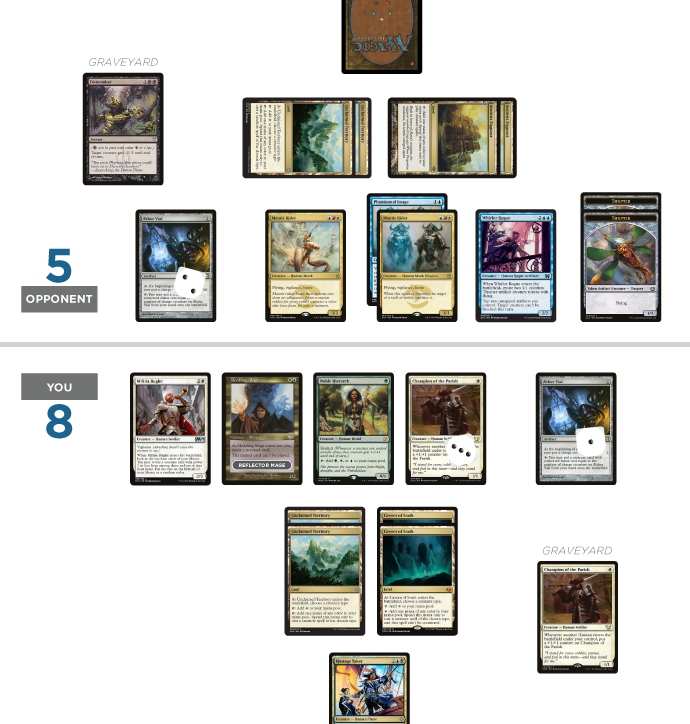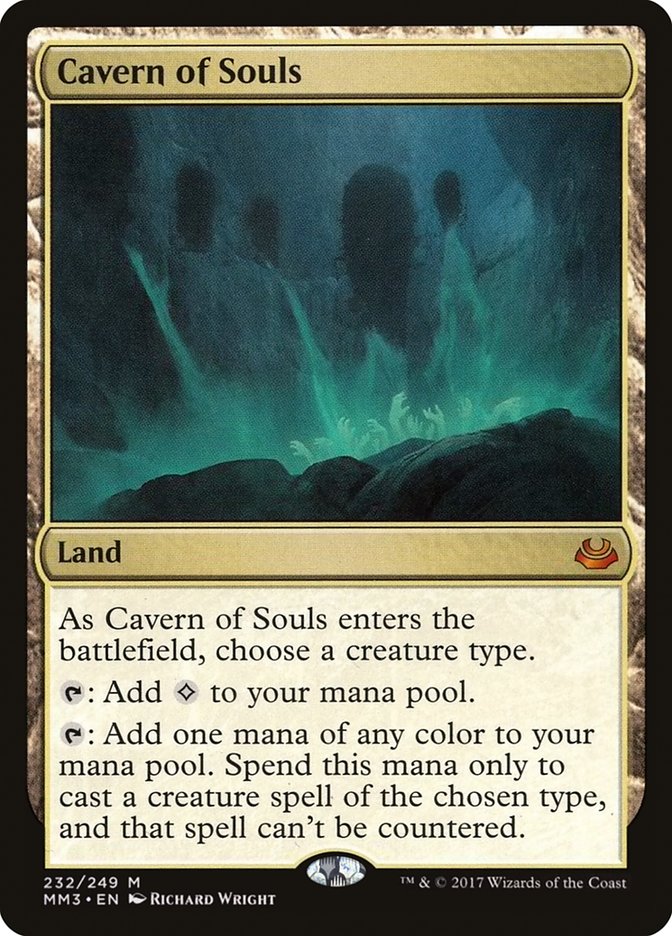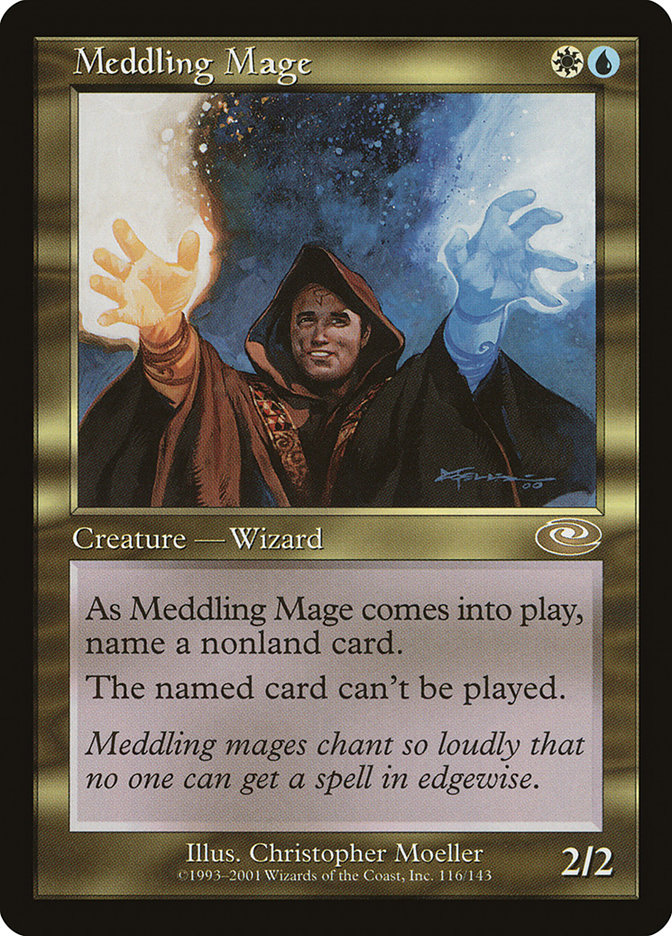Last weekend in Dallas, Team Get Tannon Agonizingly Close to a Trophy stayed true to its name with a second-place finish in the Team Constructed Open. Brand recognition is so important these days that it’s not in our best interest to win that final match.
Or at least that’s what I tell Tannon Grace to assuage the anguish that builds every time you come so close and fall short.
I know a thing or two about losing big matches, and my modus operandi is to re-watch the match and glean as much as I possibly can from the loss so that I maximize the chance of salvaging something positive from it. Fortunately, in this case, the final loss of our tournament came in Game 2 of my match, a Humans mirror that became very complicated at the end. Here is the story of that game and my evaluation of the last three turns in hindsight.
Game 2 Begins
Having lost Game 1, I opened on the play while my opponent, Brian Basoco, mulliganed to six. I came out of the gates quickly with a Champion of the Parish into a second Champion plus Noble Hierarch start, while Brian had an Aether Vial on Turn 1 and a Dismember for my larger Champion on Turn 2.
In an attempt to maintain my advantageous position for as long as possible, I cast a Meddling Mage on Turn 3 naming Reflector Mage, and Brian started using his Aether Vial to catch up by playing a Mantis Rider and putting a Phantasmal Image copying it onto the battlefield, blanking my smaller ground creatures and starting a clock of his own in the air.
I followed up with a Militia Bugler finding my singleton sideboard copy of Hostage Taker, but without another creature, my Champion of the Parish was left as a 4/4, and despite exalted from Noble Hierarch, it could be profitably double-blocked by the two fliers. I decided to attack with my Meddling Mage as a 3/3.
On his Turn 4, Brian elected to keep his Vial on two charge counters, played a fourth land, and cast his haymaker four-drop of choice, Whirler Rogue. Another attack for six and a pass of the turn left the following game state:

I’m in a tight spot and my deck served up an excellent draw step in Phantasmal Image. In my excitement I played it too quickly, thinking that copying the Whirler Rogue would let me make my Champion of the Parish unblockabe and attack for lethal, only to have my illusion felled by an activation of my opponent’s Whirler Rogue with the enters-the-battlefield trigger on the stack.
Dismayed with my recklessness, I attacked with my large Champion of the Parish, expecting a chump block from the Whirler Rogue, only to find out that my opponent’s last card was a second Phantasmal Image, this one copying Whirler Rogue to generate extra blockers.
So let’s look back at that turn. Knowing that my opponent can kill my Phantasmal Image, is it still right to cast it?
Assuming my opponent’s last card is irrelevant, then it’s better to go for the Hostage Taker on the opposing Mantis Rider (removing the lethal threat in the air and setting up to copy Whirler Rogue on the following turn), cast the hostage Mantis Rider, trade off fliers, and win with my superior ground position.
However, a deeper look at how the game played out gives us a strong read that Brian is in fact holding a second copy of Phantasmal Image. On his previous turn, Brian leaves his Aether Vial at two counters with only two cards in hand, which strongly suggests he is holding a two-drop. Now, there are a lot of two-mana creatures in Humans, but if you go down the list, the others don’t make sense.
Thalia, Guardian of Thraben and Kitesail Freebooter are the two cards that come out first in the mirror and Brian had plenty of cards in his sideboard to bring in. Meddling Mage would’ve been Vialed onto the battlefield on his turn, since my Hostage Taker was revealed by Militia Bugler. Thalia’s Lieutenant would also have entered on his turn to get two more damage in with the Mantis Riders, an important two damage, since it would leave me at six life and him with lethal damage even if I could remove or block one of the Mantis Riders the following turn.
So it’s clear that the last card is Phantasmal Image, which makes my life a lot harder. First, it means that casting Hostage Taker means I lose on the spot. He can Vial in the Image, copying my Hostage Taker to exile mine and effectively counter its ability, forcing me to target the Image of Mantis Rider to kill it via the Illusion ability. But in that scenario he simply copies Mantis Rider with the Image to re-establish lethal damage in the air.
So the correct play is to cast Phantasmal Image, and I can’t copy Mantis Rider since he can simply kill it with his Whirler Rogue, so my hasty play turned out to be correct. However, it’s obvious in hindsight that I shouldn’t have been so hasty in demonstrating lethal; had I played normally, Brian (and his teammate Dave Thomas—no, not that Dave Thomas—who was helping by this point) may have missed the unusual play with Whirler Rogue.
After losing my Image, the only good attack is with Champion of the Parish, which is chump blocked by a member of Brian’s Thopter army and I have to pass the turn.
As we go past this point, the game state is quite complicated, so you can follow along with the match on video to maintain a visual representation of the game state.
Brian elected to play conservatively on his turn, merely using his Aether Vial and a Thopter token to make the original Mantis Rider unblockable and attacking for three. He doesn’t play anything, suggesting that he drew a useless land.
I untap and find a Plains on the top of my deck, offering no help, and I have to decide how to use my Hostage Taker.
Targeting a token is clearly bad, so the only considerations are the Mantis Rider, Whirler Rogue, and the Image copies of each. Targeting the Image of Whirler Rogue is weak, since it leaves Brian with the most pressure in the air without taking away any utility from making creatures unblockable.
Targeting the Image of Mantis Rider is similarly weak, since the combination of Mantis Rider and Whirler Rogue leaves me dead in two turns with little recourse except a topdeck. I am behind and I need to turn my position around, which requires getting more value from the Hostage Taker than simply killing a creature.
The Risk
The best play for evening the battlefield is taking the Mantis Rider. I can chump block the Imaged flier for a turn before casting it and trading off, at which point my Militia Bugler and Meddling Mage can finally enter the red zone. This play also neutralizes the Whirler Rogue’s ability, since it can’t profitably target the Images, though I will have to look out for the original Whirler Rogue making itself unblockable. My goal will be to be aggressive enough that committing a creature to attack with another leaves my opponent dead on the counter-attack.
However, targeting the Whirler Rogue is enticing because it sets up lethal damage on the following turn via unblockability on Champion of the Parish, and with me at five life, an all-out attack in the air induces two chump blocks with my Thopter tokens on the Mantis Riders, leaving me at two, while using the Aether Vial and a Thopter token to make the original Rider unblockable lets me trade one Thopter and make one chump block, allowing Mantis Rider and a Thopter through and leaving me at one life.
I’d be dead to a variety of cards at this point. Gut Shot, Izzet Staticaster, Thalia’s Lieutenant, Phantasmal Image, Mantis Rider, Reflector Mage, Reclamation Sage, and even Aether Vial all do the job. As it turns out, the two Noble Hierarchs Brian did draw would’ve also been enough, letting him make the original Mantis Rider unblockable and attack for five damage after the two exalted triggers. A topdecked Meddling Mage naming Whirler Rogue would also be very problematic, leaving me dead in the air in two turns and needing to draw a Reflector Mage to win.
Despite the fact that this line would’ve lost me the game sooner, I think it’s correct to take the risk here. Despite the number of outs Brian has, I still think I’m a favorite to win the game, or at the very least a slight underdog. From my position, which I evaluated as disadvantaged, that’s the best you can hope for.
The Line I Took
Instead of taking that line, I decided to attack first with the Champion of the Parish to see how he blocks, hoping that would inform my decision. Brian wisely blocks with the original Whirler Rogue, and now I have to re-evaluate. I can now target the Imaged Whirler Rogue to take unblockability off the table, but that line still leaves me under a ton of pressure in the air with no good way to break through on the ground, and it takes away Phantasmal Image as an instant win, since there will be no more Whirler Rogues left to copy. So I target the Mantis Rider, which is better than it was before now that he doesn’t have a creature bigger than a Thopter that can be made unblockable with Whirler Rogue.
The two Noble Hierarchs that Brian drew complicated the matter, making a single Thopter token much more threatening, and he makes the straightforward play of making a Thopter unblockable and attacking for three, leaving me dead on the next turn.
Before I draw, I have the decision of whether or not to add a counter to my Aether Vial. Ultimately it’s an easy decision because I have a Meddling Mage on Reflector Mage and the third counter unlocks those draws. I’m also planning to cast the Mantis Rider here and have a fifth land to cast a two-drop afterward, but not a three.
My draw for the turn was another copy of Cavern of Souls, so no help there, and I was left to figure out how to attack in such a way as to Brian to block away enough of his battlefield that I wasn’t dead.
With only one ground creature on Brian’s side and my having Noble Hierarch and potentially Militia Bugler to block it, I’m certainly attacking with all my ground creatures. Mantis Rider also has to come in so as to force a block by the Imaged Mantis Rider on it rather than something more profitable.
That leaves us with the two Thopter tokens. Since I’m behind, my first instinct was to send them both in. However, since I’m at two, that leaves me dead to the two tapped Thopters of Brian’s, so he can throw away all his other blockers. He only needs four blockers to soak up enough damage to survive at one and he has five, so that’s no good.
The most conservative attack of leaving back both Thopter tokens is also awkward, since after blocking my Mantis Rider and Champion of the Parish, he need only block one of the two-power ground creatures to survive. Trading Mantis Riders and chump blocking with a Noble Hierarch and the untapped Thopter token leaves Brian with the Imaged Whirler Rogue, one Noble, and two Thopters, enough with his Aether Vial to make a token unblockable and attack for the final two damage.
I opted to leave one Thopter back, since that forced another block and made Brian win through a blocker on the way back. He and his team found the line of leaving themselves with all three Thopter tokens, and that was the tournament.
What Might Have Been
In a game this close, there’s no potential to bluff, since he’s either dead or drawing very slim to beat any three-drop I could’ve drawn and the cost of playing around them is losing to every irrelevant draw, so I have to take the line that is most likely to induce a mistake. I think my line does that, since, on the surface, the third Thopter token is the least valuable creature and it gives him the most to think about.
In hindsight, I believe I made one mistake in attacking with the Champion of the Parish before casting Hostage Taker and could’ve done a better job of slipping the Phantasmal Image past Whirler Rogue’s ability to steal the game.
There are some other judgement calls from earlier in the game that could’ve changed things. Mantis Rider was the other card I thought about naming with my Meddling Mage, but Reflector Mage would’ve similarly blanked my smaller creatures and resetting the Champion would’ve allowed him to get back into the game on the ground. Further, his Aether Vial made my Reflector Mages significantly worse.
The bigger decision was attacking with Meddling Mage instead of Champion of the Parish on Turn 4. If Brian decides to make the double block with his Mantis Riders and trade one for one, the game changes entirely. But if he thinks his Whirler Rogue can stall me on the ground long enough to win the race, I deal two more damage.
The winning block three turns later left him at two life.
A double block is made less likely by the fact that he just saw the Hostage Taker that turn off the Bugler trigger. I’d be able to kill the original Mantis Rider in combat and then take out the Image on the following turn, freeing my other creatures, but he might be able to turn that around by copying my Hostage Taker with his second Image and stealing two of my creatures. It’s hard to say how the game plays out from there.
The Takeaway
If there’s one takeaway from this game, it’s just how complicated Humans can be. Like every top deck in Modern, it has draws that simply curve out and run the opponent over. But it’s no mindless aggro deck. Sequencing with the deck is very intricate and a single mistake can cost you a game. And creature mirrors often have very difficult combat situations, as this game did.
I don’t think anyone would’ve come up with all of what I wrote here in-game, especially under the pressure of the finals, which is why I value the ability to look over my games after the fact. Taking the time to thoroughly analyze each turn makes future combat situations easier to manage. Sometimes the learning comes from realizing certain interactions you missed before, but more important are the heuristics you can develop over time to process difficult positions more efficiently.
You may have noticed above that my analysis of combat didn’t hinge much on which creature was best for blocking what, but in the number of blocks that needed to be made. The former is a variable that can be optimized, but in order to properly optimize it, you need to know what constraints you’re working under, and the number of blocks you need to make to survive is such a constraint.
From Brian’s side, once I made my final attack, if he had first determined that he needed to make four blocks to live, he’d know he was leaving himself with one of the untapped creatures and could easily figure out which of them allows for a lethal counterattack.
There will always be some situations where your heuristics fail, and hopefully you can recognize those and adjust on the fly, but Magic is about making complex decisions quickly and accurately, and developing good heuristics will help you do that.
Learning from your losses doesn’t take all the sting away from them, especially those in high-leverage matches, but it does make any future wins sweeter. And more likely. It’s getting old just being the handsomest and best-dressed team on the SCG Tour.





